Guide to smaller combines
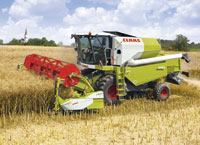
When it comes to combines, the focus of attention is usually on the biggest or the highest capacity machines. There’s an unmistakeable wow factor about them which anything smaller just seems to lack. But as far as sales are concerned, the biggest demand is not always for the largest combines.
It’s all relative of course. What is now termed a “smaller” combine – one with say four or five straw walkers – would, only a couple of decades ago, have been considered truly enormous. And sales of straw walker combines are apparently holding up well against their hi-tech rotary cousins.
This, says the industry, is because there is an acute shortage of good-quality second-hand machines, the traditional choice of smaller growers looking for a combine capable of handling around 800 acres of cereals. Why? It’s all down to the strength of the euro, which has pushed a large number of these second-hand machines into Europe, leaving growers who need a new combine with little choice other than to purchase a new one.
New Holland harvest sales product manager Nigel Honeyman says it is quite noticeable how many of these smaller combines have been swallowed up by European dealers.
“The supply of used combines for UK growers has simply dried up,” he says. “It’s a situation which has meant growers have had to opt for new machines.”
This view is echoed throughout the industry. John Deere’s combine product manager Mark Smith points out that for smaller-scale growers the purchase of a new combine is a major investment.
“Unlike the really big growers who invariably schedule machinery purchases into their business plans, there is always a temptation for these farmers to try and do just one more season with their combines,” he says. “The purchase of a new one, when it is eventually made, is an investment they expect to make perhaps once every 10 years or so.”
Deutz-Fahr marketing manager Rob Edwards says it is usual for purchasers to opt for models which are not over- embellished in the bells and whistles department.
“Most will specify a limited range of extras such as a yield loss meter, air conditioning and joystick control, but not the high-tech frills which most of the higher-end combines would have,” he says. “They want a combine which is going to last and they perceive that a load of complicated electrical gadgetry may not last the course.”
So what can you buy new for less than £200,000? All the major combine harvester manufacturers have something in their ranges and there’s a wider choice than you might imagine. Most can offer you a combine with a proven no-frills design, which should offer reliability and straightfoward technology, with the promise of a strong resale value.
Case IH
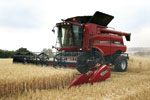 Growers looking for that sub-£200,000 combine in Case livery have a limited choice. The Axial Flow 5088 will be within this budget, but getting the larger models to fall within this threshold will require some negotiation.
Growers looking for that sub-£200,000 combine in Case livery have a limited choice. The Axial Flow 5088 will be within this budget, but getting the larger models to fall within this threshold will require some negotiation.
With 295hp under its hood, the 5088’s threshing system uses a 76cm x 2.62m three-speed variator drive rotor which Case points out is simple and requires very few belts or wearing parts. Recommended header width is 6m and the grain tank capacity is 8800 litres.
Claas
Claas says it has had a busy year with its entry-level Avero 240 and the Tucano combine harvester ranges. The Avero 240, which was introduced last year, is powered by a Cat 198hp engine. Fitted with same header mount as the Tucano, there is scope for a Vario cutterbar and also for the APS (Accelerated Pre-Separation) system along with the 3-D cleaning system for gradients up to 20%, all of which are designed to increase output.
Threshing is via a cylinder and concave and there are four walkers, an overhead agitator and a sieve area of 3sq m. Grain tank capacity is 5600 litres.
The five-walker Tucano 320 and 430 combines are powered by Mercedes Benz engines – 204hp and 258hp respectively. Both employ the same 1.3m x 45cm cylinder, but the 430 also benefits from the addition of APS.
Claas recommends these combines are fitted with a 6m Vario header but also offer sizes of 3.7m and 5.4m.
Deutz-Fahr
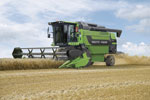 The latest addition to the Deutz-Fahr combine range is the 6040 which is now the smallest model in a line-up which also includes the 6060 and 6065 versions at its lower end.
The latest addition to the Deutz-Fahr combine range is the 6040 which is now the smallest model in a line-up which also includes the 6060 and 6065 versions at its lower end.
The 6040 is powered by a 222hp Deutz engine and is available with cutting heads of 4.2m, 4.8m and 5.4m. Five straw walkers provide 7.36sq m of separation area and the sieve area is 5.28 sq m. Tank capacity is 6500 litres.
The larger 250hp 6060 and the 310hp 6065 are also available as Balance machines which can provide automatic self levelling to the tune of 20% lateral movement and 6% fore and aft.
Both models have five straw walkers and employ a traditional threshing drum and concave system – TS versions have a turbo-separator. Grain tank capacity is 7500 litres.
John Deere
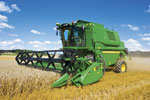 Two new entry-level combines made their way into John Deere’s line-up for the 2010 season. The 240hp five-walker 1470 and 262hp six-walker 1570 each employ a conventional threshing drum system – a 610mm diameter drum and concave.
Two new entry-level combines made their way into John Deere’s line-up for the 2010 season. The 240hp five-walker 1470 and 262hp six-walker 1570 each employ a conventional threshing drum system – a 610mm diameter drum and concave.
Straw walker and sieve area on the 1470 is 4.83sq m and 1.88sq m and, for the 1570 with its six straw walkers this is 5.79sq m and 2.38sq m. Grain tank capacity for both models is 6800 litres.
Options include the company’s HeaderTrak which provides automatic control of table height and lateral tilt when working on slopes. A straw chopper and chaff spreader can also be specified.
Laverda
Sub-£200,000 combines from Laverda include the Iveco-powered REV range – the 225hp REV 225, 245hp REV 255 and the 245hp REV 256.
Header options extend from 4.2m to 6.6m. The smaller two five-walker models are fitted with a 60cm x 1.3m cylinders and the six walker REV 256 has a 60cm x 1.6m cylinder.
Separation area on the walkers is 6.7sq m and 7.9sq m and sieve area is 4.6sq m and 5.6sq m. Grain tank capacity is 7000 litres and 7500 litres respectively, with an emptying rate of 85 litres/second.
Massey Ferguson
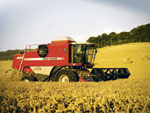 Massey Ferguson’s sub-£200,000 combine range is generous and majors on its Iveco-powered Activa models. Aimed at owner-operators, they are said to offer modern, straightforward technology.
Massey Ferguson’s sub-£200,000 combine range is generous and majors on its Iveco-powered Activa models. Aimed at owner-operators, they are said to offer modern, straightforward technology.
First in the queue is the 176hp 7240, 226hp 7244 and the 243hp 7245 which use a 1.34m x 60cm cylinder and five straw walkers, and then there is the 243hp 7246 which has a 1.6m x 60cm cylinder and six straw walkers.
Apart from the smallest model which has a 5200 litre grain tank, all other Activa combines are fitted with a 7000 litre tank.
New Holland
 New Holland’s TC5000 series involves three models with five straw walkers at a price significantly below our £200,000 threshold.
New Holland’s TC5000 series involves three models with five straw walkers at a price significantly below our £200,000 threshold.
The 175hp 5060, 223hp 5070 and 242hp 5080 employ an eight-bar threshing drum and concave system with a 60cm diameter and 1.3m width. Threshing is helped by a rear beater and the five straw walkers provide a separation area of 5sq m and the upper and lower sieves provide a combined area of 4.12 sq m.
Recommended header widths range from 3.66m through to 6.03m and grain tank capacity is 5200 litres for the TC5060, increasing to 6000 litres for the 5070 and 5080 models.
Sampo-Rosenlew
A brand more associated with smaller-sized combines than most, Sampo-Rosenlew’s combine range is marketed in the UK by Essex-based Trials Equipment.
A new model, the 2045HT, is set to make its debut in 2011. With a choice of 120hp or 150hp engines, it becomes the smallest model in the company’s UK range.
It joins the existing five-walker 2065HT, 2085TS and 2095TS models and the key difference would appear to be the available power rather than any significant design changes, apart from grain tank capacity.
Common to all models is the use of a ‘double’ concave – a heavy duty cylinder which is followed by a conventional cylinder. This system was originally designed for use in maize but is now available as standard throughout the range.

